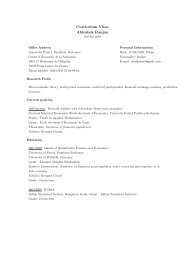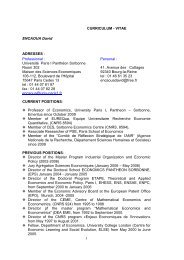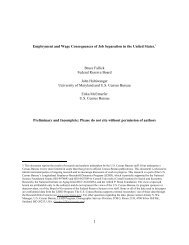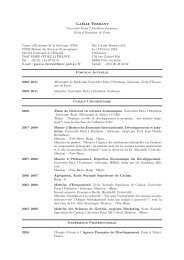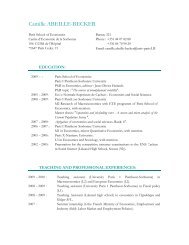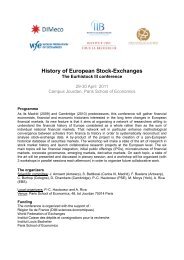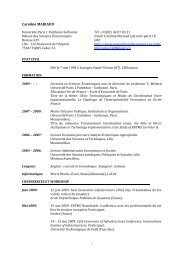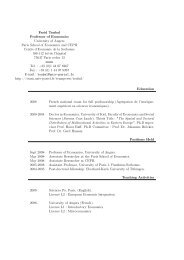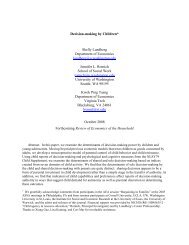info document - Paris School of Economics
info document - Paris School of Economics
info document - Paris School of Economics
You also want an ePaper? Increase the reach of your titles
YUMPU automatically turns print PDFs into web optimized ePapers that Google loves.
Table 2: Decomposing the Change in Log 90-10 Wage DifferentialTotal Change Percentage due toin Log 90-10 Log 90-50 Log 50-10CEU 0.07 91% 9%US-UK 0.21 76% 24%Difference 0.14 68% 32%individuals in an economy with a compressed wage structure will not increase their investmentsas much as in an economy with a less progressive tax schedule. As a result, the modelpredicts that countries with a more redistributive tax system will not experience a largeincrease in inequality in response to SBTC, but will also not be able to accumulate therequisite human capital, and therefore experience the growth surge that happens severaldecades after the onset <strong>of</strong> SBTC.We assume all countries to have the same innate ability distribution but allow eachcountry to differ in the observable dimensions <strong>of</strong> their labor market structure, such as inlabor (and consumption) tax schedules, and in unemployment insurance and retirementbenefits system, among others (although it turns out that the tax system is the dominantfactor in the quantitative results below). These policy differences explain about 2/3 <strong>of</strong> theobserved gap in wage inequality between US-UK and CEU at the beginning <strong>of</strong> 21st century.Second, when we choose the degree <strong>of</strong> skill-biased technical change between 1980 to 2000to match the rise in wage inequality in the US during this period, the model explains about60% <strong>of</strong> the observed gap in the rise in wage inequality between US-UK and CEU duringthis time period. Finally, the smaller inequality in the CEU comes at the expense <strong>of</strong> loweremployment and lower GDP per capita since workers do not accumulate as much humancapital as in the US.In a recent paper, Guvenen and Kuruscu [2007] has studied a stylized version <strong>of</strong> thepresent framework—one that abstracts from idiosyncratic shocks as well as from all theinstitutional details studied here—and applied it to U.S. data. It concluded that even thatstark version <strong>of</strong> the model provides a fairly successful account <strong>of</strong> several trends observed inthe U.S. data since the 1970’s, including the rise in overall wage inequality; the initial fall inthe college premium in 1970’s and the subsequent strong increase in the next two decades;the rise in within-group wage inequality; the stagnation in aggregate productivity growth,and the small rise in consumption inequality despite the large rise in wage inequality. Inthis paper, we build on this research by explicitly modeling labor market institutions andallowing for idiosyncratic shocks to provide a detailed quantitative assessment <strong>of</strong> the rolethe paper.4



